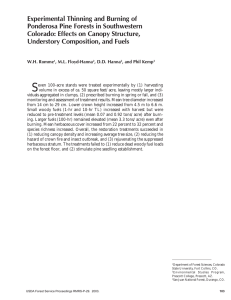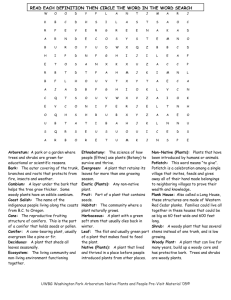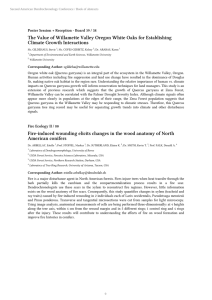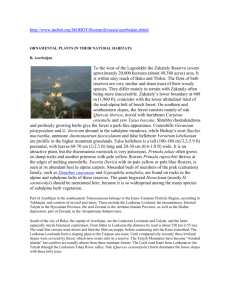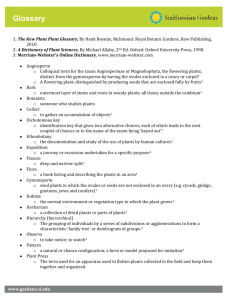The Role of Prescribed Burning in Regenerating
advertisement
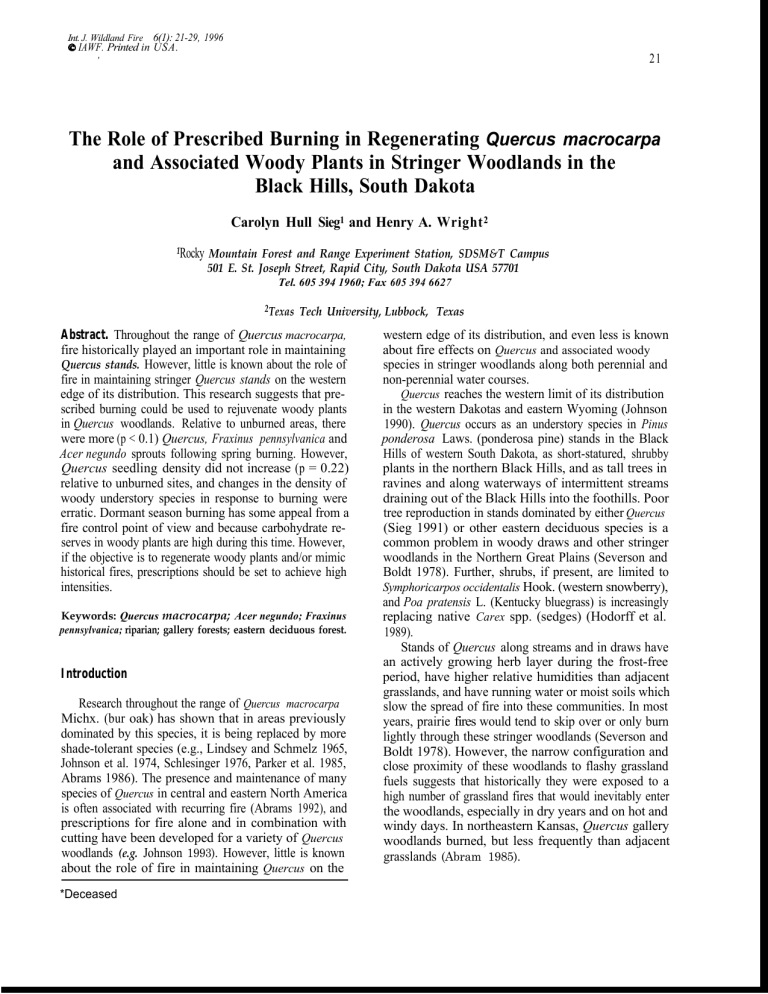
6(1): 21-29, 1996 8 IAWF. Printed in USA. , Int. J. Wildland Fire 21 The Role of Prescribed Burning in Regenerating Quercus macrocarpa and Associated Woody Plants in Stringer Woodlands in the Black Hills, South Dakota Carolyn Hull Sieg1 and Henry A. Wright 2 1Rocky Mountain Forest and Range Experiment Station, SDSM&T Campus 501 E. St. Joseph Street, Rapid City, South Dakota USA 57701 Tel. 605 394 1960; Fax 605 394 6627 2Texas Tech University, Lubbock, Texas Abstract. Throughout the range of Quercus macrocarpa, fire historically played an important role in maintaining Quercus stands. However, little is known about the role of fire in maintaining stringer Quercus stands on the western edge of its distribution. This research suggests that prescribed burning could be used to rejuvenate woody plants in Quercus woodlands. Relative to unburned areas, there were more (p < 0.1) Quercus, Fraxinus pennsylvanica and Acer negundo sprouts following spring burning. However, Quercus seedling density did not increase (p = 0.22) relative to unburned sites, and changes in the density of woody understory species in response to burning were erratic. Dormant season burning has some appeal from a fire control point of view and because carbohydrate reserves in woody plants are high during this time. However, if the objective is to regenerate woody plants and/or mimic historical fires, prescriptions should be set to achieve high intensities. Keywords: Quercus macrocarpa; Acer negundo; Fraxinus pennsylvanica; riparian; gallery forests; eastern deciduous forest. Introduction Research throughout the range of Quercus macrocarpa Michx. (bur oak) has shown that in areas previously dominated by this species, it is being replaced by more shade-tolerant species (e.g., Lindsey and Schmelz 1965, Johnson et al. 1974, Schlesinger 1976, Parker et al. 1985, Abrams 1986). The presence and maintenance of many species of Quercus in central and eastern North America is often associated with recurring fire (Abrams 1992), and prescriptions for fire alone and in combination with cutting have been developed for a variety of Quercus woodlands (e.g. Johnson 1993). However, little is known about the role of fire in maintaining Quercus on the *Deceased western edge of its distribution, and even less is known about fire effects on Quercus and associated woody species in stringer woodlands along both perennial and non-perennial water courses. Quercus reaches the western limit of its distribution in the western Dakotas and eastern Wyoming (Johnson 1990). Quercus occurs as an understory species in Pinus ponderosa Laws. (ponderosa pine) stands in the Black Hills of western South Dakota, as short-statured, shrubby plants in the northern Black Hills, and as tall trees in ravines and along waterways of intermittent streams draining out of the Black Hills into the foothills. Poor tree reproduction in stands dominated by either Quercus (Sieg 1991) or other eastern deciduous species is a common problem in woody draws and other stringer woodlands in the Northern Great Plains (Severson and Boldt 1978). Further, shrubs, if present, are limited to Symphoricarpos occidentalis Hook. (western snowberry), and Poa pratensis L. (Kentucky bluegrass) is increasingly replacing native Carex spp. (sedges) (Hodorff et al. 1989). Stands of Quercus along streams and in draws have an actively growing herb layer during the frost-free period, have higher relative humidities than adjacent grasslands, and have running water or moist soils which slow the spread of fire into these communities. In most years, prairie fires would tend to skip over or only burn lightly through these stringer woodlands (Severson and Boldt 1978). However, the narrow configuration and close proximity of these woodlands to flashy grassland fuels suggests that historically they were exposed to a high number of grassland fires that would inevitably enter the woodlands, especially in dry years and on hot and windy days. In northeastern Kansas, Quercus gallery woodlands burned, but less frequently than adjacent grasslands (Abram 1985). 22 Sieg, C.H. and Wright, H.A. _ Because deciduous trees and shrubs sprout from rhizomes, root collars, or stems, they survive or even expand when topkilled by fire. White (1983, 1986) suggested that prescribed burning could be used to “thin stands from below,” whereby fires topkill smaller Quercus trees, leaving larger trees as acorn producers. Many other woody species occurring in Quercus stands, including Prunus virginiana L. (chokecherry) and Symphoricarpos sprout following burning (Wright and Bailey 1982). Burning with sufficient severity to reduce the canopy cover of the overstory will also enhance light levels. Survival of Quercus reproduction in the eastern and central United States is highly dependent on disturbances that increase light levels (Johnson 1993). Further, in the southern Black Hills (Schripsema 1977) and in other regions (e.g., Curtis and Partch 1948) fire is useful in reducing the cover of Poapratensis, thus possibly providing microsites more favorable for the establishment of woody species that require mineral seedbeds for germination. Establishment of Q. rubra Du Roi-Little (red oak) in Mississippi was less successful where Poa was the predominant cover, compared to areas covered by shrubs and dense ferns (Scholz 1955). Removal of litter enhanced germination rates of acorns in Iowa uplands (Krajicek 1960). Mineral soils warm more quickly in the spring than soils covered by litter and this may also improve Quercus germination. Although few quantitative data are available on the historical fire frequency in the Black Hills area, evidence suggests that fires were ecologically important in this region. Comparisons of photographs taken in 1874 during General Custer’s expedition to the area with those taken 100 years later (Progulske 1974, Progulske and Shideler 1984) show that Pinus coverage has greatly increased, due at least in par t to fire suppression efforts since the arrival of Europeans. Opal phytolith analyses in the Devil’s Tower region northwest of the Black Hills indicated that Pinus densities have increased in the last 100 years, and that grasslands and savannas have been invaded with Pinus (Fisher et al. 1987). Dendrochronology data in this same area revealed that between 1600 and 1770, the mean interval between fires was 27 years; from 1770 to 1900 the fire return interval was 14 years, and since 1900 fires burned on the average of every 42 years (Fisher et al. 1987). The purpose of this study was to explore the role of fire in Quercus stringer forests on the eastern edge of the Black Hills. We hypothesized that where fuels were relatively continuous and dry, prescribed burning would increase tree sprouts and shrub densities and provide a microclimate for the establishment of Quercus seedlings. We also sought to identify plant and/or site characteristics that contributed to the response of woody plants following burning. McPherson et al (1990) is the authority for terminology used in this paper that pertains to fire management. Study Area The study area is located in Meade County, South Dakota, south of the town of Sturgis, in the Fort Meade Recreation Area. The 3000-ha Recreation Area was originally established as a Military Reservation in 1878 (Bureau of Land Management 1981). The Bureau of Land Management manages the Recreation Area for livestock grazing, forestry, wildlife, and a variety of recreational uses. Vegetation on the Recreation Area consists of mixedgrass prairie dissected by intermittent streams an d pinecovered outcrops. Major grassland species include Andropogon scoparius Michx. (little bluestem) and A. gerardii Vitman (big bluestem), Agropyron smithii Rydb. (western wheatgrass), a nd Stipa viridula Trin. (green needlegrass) . Quercus, Fraxinus pennslyvanica Marsh. (green ash), an d Ulmus americana L. (American elm) are major tree species along drainageway. Pinus dominates sandstone and shale outcrops. Elevation of the study area ranges between 1030 and 1130 m, and the area receives an annual average of 45 cm of precipitation (National Oceanic and Atmospheric Administration 1986). Annual precipitation totaled 74.6, 39.2, and 45.5 cm during the three years of this study. Average annual temperatures during the three years wer e 7.5, 9.6, and 9.8o C, respectively. Methods A total of 192 square 6- by 6-m plots were established and fenced to exclude livestock in 1986. The plots were randomly located in Quercus woodlands, and were distributed among four study sites (48 per site). Two of the four sites were on the floodplain and associated ravine of intermittent creeks, and two sites were in draws with ephemeral streams. On each site, 24 plots were burned in April 1987. Both burned and unburned plots were stratified to include similar ranges in slope, fuel load, soils, and aspect. Plots were located on relatively level floodplains, steep slopes either above the floodplains or along the sides of draws, draw bottoms, and some cut banks associated with channels. To maximize ease of burning, burned plots were clumped at one end of each site. Pretreatment Data Pretreatment data included overstory and understory woody plant densities, as well as soil and fuel character- istics. The overstory was characterized by measuring the diameter, height, number of juvenile crown sprouts, and condition of each tree 2 2.5 cm dbh, by species, in each plot. Ages of trees were approximated by counting annuli in increment cores taken at breast height from each - Prescribed Burning and Quercus macrocarpa Regeneration tree. Density of seedlings and saplings < 2.5 cm dbh and woody understory species was measured by counting numbers of stems, by species, in five square 2- by 2-m quadrats in each plot. Great Plains Flora Association (1986) was the authority for plant nomenclature. Fine fuel loads were estimated in late summer 1986 by clipping herbaceous material at ground level in 10 20by 50-cm quadrats randomly located in each 6- by 6-m plot. Materials were oven-dried at 60o C for 48 hours and weighed. Downed, woody fuels were recorded by diameter class (<0.6 cm, 0.6 - 2.5 cm, 2.6 - 7.5 cm, > 7.5 cm) along two 6-m transects in each plot; these data were summed for estimates of total woody fuel loads (Brown et al. 1982). Other measurements taken in each plot included: percent overstory frequency (determined with a box prism at four points in each plot), slope (&), and aspect (degrees). Surface soil moisture (O-2 cm) was determined gravimetrically (weighed, dried at 100o C for 48 hr, reweighed) in late July from four samples per plot; soil penetration was estimated from four randomly-located penetrometer readings in each 6- by 6-m plot. In addition, each plot was characterized with respect to landscape position (e.g. floodplain, slope, ravine bottom, cut bank). Prescription Given that these stringer forests are relatively green and moist during most of the growing season, and that woody species generally have the highest carbohydrate reserves during the dormant season (Kozlowski 1992), we set the prescription to burn the plots in the fall following a hard frost or in the spring before the trees had leafed out or cool season grasses had begun significant growth. The prescription called for temperatures between 16 and 27o C, relative humidity 25-40&, and wind speeds 13-24 kph; headfires were the preferred ignition technique to achieve maximum topkill of woody species (Wright and Bailey 1982). The preferred range of fuel moisture in fine (l-hour timelag) fuels was 7 - 20% (Mobley et al. 1973); in 10-hr. fuels (0.6 - 2.5 cm diameter), the preferred range was 6 - 15% (Beaufait 1966); and in 100+ hr. timelag fuels (> 2.6 cm diameter), the prescription called for moisture contents < 17% (Wright and Bailey 1982). Prescribed Burns Fuel and soil moisture were estimated and weather was monitored the day the plots were prescribed burned (17 April 1987). The percentage of the plant canopy cover in the understory that was green was estimated by 6 cover classes (Daubenmire 1959) in 2 randomly located 50- by 20-cm quadrats adjacent to each plot. Fine fuel moisture was then estimated by harvesting herbaceous plants at ground level in these 2 quadrats adjacent to each plot. Harvested material was weighed in the field, dried at 105o C for 48 hours, and reweighed. Moisture of larger fuels was estimated with fuel moisture sticks (lo-hour timelag fuels) and a fuel moisture probe (100-hour timelag fuels). Soil moisture at the time of the burn was determined gravimetrically (weighed, dried at 100 o C for 48 hr, reweighed) from one random sample in each plot. Relative humidity, wind speed (20-30 cm above soil surface), and air temperatures were monitored every 15 minutes during the fires. Rate of spread of the flames was estimated with a stopwatch. Total time to travel across plots (6 m) was recorded. Post-treatment Data Following burning, woody overstory and understory species were sampled for two consecutive years in a similar manner to pretreatment measurements. In addition, tree scorch heights (height of scorch on tree boles) were recorded, and each plot was systematically searched for Quercus seedlings. Seedlings were counted and marked in July following the burns; seedling survival was estimated the following July as the number of marked seedlings alive in each plot. Statistical Analyses Number of tree sprouts and woody understory density were compared separately, by species, across four sites and treatments (burned and unburned) by analysis of covariance (Steel and Torrie 1980). Potential covariates included in analyses were slope, aspect, pretreatment value, soil moisture, soil penetration, landscape position, and overstory frequency. If a significant treatment by site interaction was detected, individual sites were analyzed by analysis of covariance, with Bonferroni corrections (e.g., a/4) to maintain Type I error protection across individual analyses (Miller 1981). If a significant difference was detected between burned and unburned plant response, regression analysis was used to examine relationships between plant response and factors such as fine fuel loads, woody fuel loads, tree age and scorch height on trees. If a species did not occur on all sites, only those sites where it occurred were included in the analyses. Aspect data were recoded as four dummy variables for analyses, where 1 = “yes” and 0 = “no” for each of the four cardinal directions; landscape position was similarly recoded into six dummy variables. Normality was tested by plotting residuals. Homogeneity of variances was tested with Bartlett’s Box F test; variances were homogeneous. 28 Sieg, C.H. and Wright, H.A. sites. Ribes spp. responded erratically to burning. Soil compaction was an impediment to R. missouriense growth, as indicated by the decrease in density with increasing soil compaction. We attributed both the decline in R. missouriense and R. odoratwn on some sites and no change in species such as Ostrya, Celastrus and Ulmus to a combination of low fire intensity and relatively dry conditions following the burns. Light surface fires ignited in the fall in the southern Black Hills reduced densities of Ribes, but had no significant impact on densities of 10 other woody species; in contrast, a fall crown fire in the same area increased densities of all shrub species except P. virginiana and Toxicodendron (Bock and Bock 1984). Quercus seedlings. Burning did not enhance germination rates of acorns nor survival of Quercus seedlings. Further, the relationship between seedling density and site factors was unclear. The only variable that was significantly correlated with Quercus seedling density was canopy cover of Carex spp. (sedges) (Sieg 1991). Further research, including information on long-term survival of various forms of woody plant reproduction, is needed. Prescription recommendations. These initial results suggest that prescribed burning shows some promise for rejuvenating woody plants in Quercus stands; but modification of the prescription is necessary. From a fire control point of view, spring and fall burning have appeal. In addition, woody plants have higher carbohydrate reserves when they are dormant (Kozlowski 1992). However, prescriptions should be set to achieve high intensities if the goal is to regenerate trees and shrubs and/or to approximate historical fire effects. Some combination of cutting and burning may be helpful in reducing the overstory and stimulating Quercus and woody plant reproduction, and multiple burns may be needed to greatly enhance Quercus regeneration (Johnson 1993). If woody plant regeneration is the goal and dormant season burns are used, the following guidelines are suggested: 1) burn in the’fall so grasses are not matted down from snow; 2) wait until after a killing frost when the percentage of green grass canopy cover is <25&; 3) defer livestock grazing, if necessary, to ensure that fine fuel loads are consistently >700 kg/ha; 4) wait for wind speeds in excess of 13 km/hr; and 5) enhance woody fuels by either not allowing fuel wood cutting and scavenging, or by scattering and leaving slash following cutting to increase fire residence times. The response of woody plants to prescribed burning in these stringer woodlands is influenced by soil moisture levels following burning, which are ameliorated by topographic features. On steep slopes, and with relatively low precipitation levels following burning, the sprouting response of woody plants in stringer woodlands will likely be lower relative to the response that could be expected on moist sites in wet years. Summary Prescribed burning shows some promise for regenerating woody plants in Quercus woodlands. Relative to unburned areas, there were more Quercus, Fraxinus and Acer sprouts following burning. However, Quercus seedling density did not increase relative to unburned sites, and changes in the density of woody understory species were erratic. Toxicodendron and Crataegus were the only woody species that increased consistently the first growing season following burning; P. virginiana density increased on some sites. Pretreatment sprout numbers and density of sampled species were the most common significant covariates for the response of plants to fire, indicating that pre-fire species composition is an important determinant in the response of deciduous woodland species. Other common covariates included aspect, soil moisture, and slope. Woody plant density was often higher following burning where soils were moist and topographic features ameliorated harsh site conditions. Dormant season burning has some appeal from a fire control point of view and because carbohydrate reserves in woody plants are high during dormancy. However, if the objective is to regenerate woody plants and/or mimic historic fires, the prescription should be set to achieve high intensities. Additional research is needed to fine-tune the prescription to achieve this objective. Acknowledgments. This was a cooperative project with the Bureau of Land Management, Belle Fourche Area Office. Billy McIllvane, Dale Tribby, Mark Stiles, and Chuck Berdan were helpful throughout the study. Dr. Guy McPherson, Associate Professor, University of Arizona; Dr. Al Steuter, Director of Science and Stewardship, Niobrara Valley Preserve; and Dr. Paul S. Johnson, Principal Silviculturist, U.S. Forest Service North Central Forest Experiment Station, provided comments useful in revising an earlier version of this manuscript. References Abrams, M.D. 1985. Fire history of oak gallery forests in a northeast Kansas tallgrass prairie. American Midland Naturalist 114:188-191. Abrams, M.D. 1986. Historical development of gallery forests in northeast Kansas. Vegetatio 65:29-37. Abrams, M.D. 1992. Fire and the development of oak forests.BioScience 42:346-353. Armour, C.D., S.C. Bunting, and L.F. Neuenshwander. 1984. Fire intensity effects on the understory in ponderosa pine forests. Journal of Range Management 37:44-49. Beaufait, W.R. 1966. Prescribed fire planning in the Intermountain West. United States Department of Agriculture, Forest Service Research Paper INT-26, Intermountain Forest and Range Experiment Station, Ogden, Utah. 27 pp. Biswell, H.H. 1989. Prescribed burning in California wildlands vegetation management. University of California Press, Berkeley. 255 pp. Prescribed Burning and Quercus macrocarpa Regeneration Bock, J. H. and C. E. Bock. 1984. Effect of fires on woody vegetation in the pine-grassland of the southern Black Hills. American Midland Naturalist 112:35-42. Brown, J.K., R.D. Oberheu, andC.M. Johnston. 1982. Handbook for inventorying surface fuels and biomass in the interior West. United States Department of Agriculture, Forest Service General Technical Report INT-129. Intermountain Forest and Range Experiment Station, Ogden, Utah. 20 pp. Bureau of Land Management. 198 1. Fort Meade recreation management plan. United States Department of Interior, Bureau of Land Management, Miles City, Montana. 47 pp. Curtis, J. T. and M.L. Partch. 1948. Effect of fire on the competitionbetweenbluegrassandcertainprairieplants. American Midland Naturalist 39: 437-443. Daubenmire, R. 1959. A canopy coverage method of vegetation analysis. Northwest Science 33: 43-64. Fisher, R. F., M.J. Jenkins, and W.F. Fisher. 1987. Fire and the prairie-forest mosaic of Devils Tower National Monument. American Midland Naturalist 117: 250-257. Fowells, H.A. 1965. Silvics of forest trees of the United States. United States Department of Agriculture, Agricultural Handbook 27 1. United States Government Printing Office, Washington, DC. 762 pp. Great Plains Flora Association. 1986. Flora of the Great Plains. University Press of Kansas, Lawrence. 1392 pp. Hodorff, R.A., C.H. Sieg, and R.L. Linder. 1988. Wildlife response to stand structure of deciduous woodlands. Journal of Wildlife Management 52: 667-673. Johnson, H.S. and J.S. Berkebile, and G.R. Parker. 1974. An ecological inventory of Bryan Nature Preserve. Proceedings of the Indiana Academy of Science 83: 167-172. Johnson, P.S. 1977. Predicting oak stump sprouting and sprout development in the Missouri Ozarks. United States Department of Agriculture, Forest Service Research Paper NC- 149, North Central Forest Experiment Station, St. Paul, Minnesota.. 11 pp. Johnson, P.S. 1990. Bur oak. In Silvics of North America, Volume 2. (R.M. Burns and B.H. Honkala, Technical Coordinators). United States Department of Agriculture, Forest Service Agricultural Handbook 654, United States Government Printing Office, Washington, D.C. Pp. 686-692. Johnson, P.S. 1993. Perspectives on the ecology and silviculture of oak-dominated forests in the central and eastern states. United States Department of Agriculture, Forest Service General Technical Report NC-153, North Central Forest Experiment Station, St. Paul, Minnesota. 28 pp. Johnson, V.J. 1984. Prescribed burning - requiem or renaissance? Journal of Forestry. 82: 82-90. Krajicek, J.E. 1960. Some factors affecting oak and black walnut reproduction. Iowa State Journal of Science 34: 631-634. Kozlowski, T.T. 1992. Carbohydrate sources and sinks in woody plants. The Botanical Review 58: 107222. Lindsey, A.A. and D.V. Schmelz. 1965. Comparison of Donaldson’s Woods in 1964 with its 1954 forest map of 20 acres. Proceedings Indiana Academy of Science 74: 169-174. McPherson, G.M., D.D. Wade, and C.B. Phillips. 1990. Glossary of wildland fire management terms used in the United States. University of Arizona Press, Tucson. Miller, H.A. 1963. Use of fire in wildlifemanagement. Proceedings Tall Timbers Fire Conference. 2: 19-30. Miller, R.G. 1981. Simultaneous statistical inference. 2nd Edition. Springer-Verlag, New York. 29 Mobley, H.E., R.S. Jackson, W.E. Balmer, W.E. Ruziska, and W.A. Hough. 1973. A guide for prescribed fire in southern forests. United States Department of Agriculture, Forest Service Southern Region, Atlanta, Georgia. 39 pp. National Oceanic and Atmospheric Administration. 1986. Climatological data annual summary, South Dakota National Climatic Data Center, Asheville, North Carolina. 91: 13. Parker, G.R., D.J. Leopold, and J.K. Eichenberger. 1985. Tree dynamics in an old-growth, deciduous forest. Forest Ecology and Management 11: 31-57. Pelton, J. 1953. Studies in the life history of Symphoricarpos occidentalis in Minnesota. Ecological Monograph 23: 17-19. Progulske, D.R. 1974. Yellow ore, yellow hair, yellow pine. A photographic study of a century of forest ecology. Agricultural Experiment Station Bulletin 616. South Dakota State University, Brookings. 169 pp. Progulske, D.R. and F.J. Shideler. 1984. Following Custer. Agricultural Experiment Station Bulletin 674, South Dakota State University, Brookings. 139 pp. Schlesinger, R.C. 1976. Hard maples increasing in an upland forest stand. In Central Hardwoods. Conference (edited by J.S. Fralish, G.T. Waver and R.G. Schlesinger), Department Forestry, Southern Illinois University, Carbondale. Pp. 177185. Scholz, H.F. 1955. Growth of northern red oak seedlings under variable conditions of ground cover. Lake States Forest Experiment Station Technical Note 430. Schripsema, J.R. 1977. Ecological changes on pine-grassland burned in spring, late spring, and winter. Master of Science Thesis, South Dakota State University, Brookings. 99 pp. Severson, K.E. andC.E. Boldt. 1978. Cattle, wildlife andriparian habitats in the western Dakotas. In Management and use of Northern Plains Rangeland. Regional Rangeland Symposium. NorthDakotaStateUniversity,Dickinson. Pp.91-102. Sieg, C.H. 1991. Ecology of bur oak woodlands in the foothills of the Black Hills, South Dakota. PhD Dissertation. Texas Tech University, Lubbock Texas. 185 pp. Steel, R.G.D. and J.H. Torrie. 1980. Principles and procedures of statistics - a biometric approach. McGraw-Hill Book Company, New York. 633 pp. Wali, M.K., K.T. Killingbeck, R.H. Bares, and L.E. Shubert. 1980. Vegetation-environment relationships of woodland and shrub communities, and soil algae in western North Dakota. North Dakota REAP Project 7-01-1, No. 79-16, Department of Biology, University of North Dakota, Grand Forks.. 145 pp. Wasser, C.H. 1982. Ecology and culture of selected species useful in revegetating lands in the west. United States Department of the Interior, Fish and Wildlife Service. FWS/ OBS-82/56. United States Government Printing Office, Washington, D.C. 347 pp. White, A.S. 1983. The effects of thirteen years of annual prescribed burning on a Quercus ellipsoidalis community in Minnesota Ecology 64: 1081-1085. White,A.S. 1986. Prescribedbumingforoaksavannarestoration in central Minnesota. United States Department of Agriculture, Forest Service Research Paper NC-266. North Central Forest Experiment Station, St. Paul, Minnesota 12 pp. Wright, H.A. 1974. Range burning. Journal of Range Manage. 27: 5-1 1. Wright, H.A. and A.W. Bailey. 1982. Fire Ecology - United States and Southern Canada. John Wiley and Sons, New York. 501 pp. World Fire: The Culture of Fire on Earth / Stephen J. Pyne 1995 A history of Earth is unintelligible without a history of fire. Although other planets have elements of combustion, only Earth has all the essential elements as well as the means to combine them. More profoundly, our planet possesses a creature not merely adapted to fire’s presence-or even prone to exploit and encourage fire - but one capable of starting and stopping it. World Fire is the story of how fire and humans have coevolved, like the bonded strands of a DNA molecule. The prevalence of humans is largely attributable to their control over fire, and the distribution and characteristics of fire have become deeply dependent on humans. The two are inseparable, and together they have repeatedly remade the landscape. 384 pages - Hardcover $35.00 Includes Shipping To order call +1 (509) 283-2397 or 800-697-3443 (inside US)
